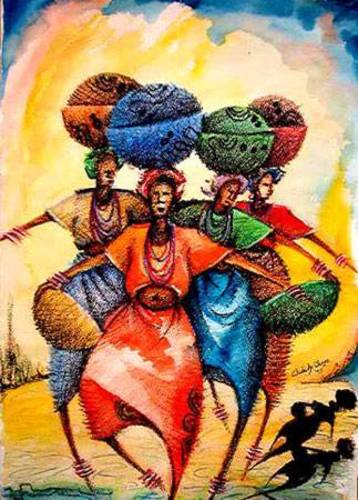African Art
African Art
African art constitutes one of the most diverse legacies on earth. Though many casual observers tend to generalize "traditional" African art, the continent is full of peoples, societies, and civilizations, each with a unique visual special culture. The definition also includes the art of the African Diasporas, such as the art of African Americans. Despite this diversity, there are some unifying artistic themes when considering the totality of the visual culture from the continent of Africa.
- Emphasis on the human figure: The human figure has always been a the primary subject matter for most African art, and this emphasis even influenced certain European traditions. For example in the fifteenth century Portugal traded with the Sapi culture near the Ivory Coast in West Africa, who created elaborate ivory saltcellars that were hybrids of African and European designs, most notably in the addition of the human figure (the human figure typically did not appear in Portuguese saltcellars). The human figure may symbolize the living or the dead, may reference chiefs, dancers, or various trades such as drummers or hunters, or even may be an anthropomorphic representation of a god or have other votive function. Another common theme is the inter-morphosis of human and animal.
- Visual abstraction: African artworks tend to favor visual abstraction over naturalistic representation. This is because many African artworks generalize stylistic norms. Ancient Egyptian art, also usually thought of as naturalistically depictive, makes use of highly abstracted and regimented visual canons, especially in painting, as well as the use of different colors to represent the qualities and characteristics of an individual being depicted.
- Emphasis on sculpture: African artists tend to favor three-dimensional artworks over two-dimensional works. Even many African paintings or cloth works were meant to be experienced three-dimensionally. House paintings are often seen as a continuous design wrapped around a house, forcing the viewer to walk around the work to experience it fully; while decorated cloths are worn as decorative or ceremonial garments, transforming the wearer into a living sculpture.
- Emphasis on performance art: An extension of the utilitarianism and three-dimensionality of traditional African art is the fact that much of it is crafted for use in performance contexts, rather than in static ones. For example, masks and costumes very often are used in communal, ceremonial contexts, where they are "danced." Most societies in Africa have names for their masks, but this single name incorporates not only the sculpture, but also the meanings of the mask, the dance associated with it, and the spirits that reside within. In African thought, the three cannot be differentiated.
- Nonlinear scaling: Often a small part of an African design will look similar to a larger part, such as the diamonds at different scales in the Kasai pattern at right. Louis Senghor, Senegal’s first president, referred to this as “dynamic symmetry.” William Fagg, the British art historian, compared it to the logarithmic mapping of natural growth by biologist D’Arcy Thompson. More recently it has been described in terms of fractal geometry
Africa is home to a great and thriving contemporary art culture. This has been sadly understudied until recently, due to scholars' and art collectors' emphasis on traditional art. Notable modern artists include Marlene Dumas,William Kentridge, Kendell Geers, Yinka Shonibare, Zerihun Yetmgeta, Odhiambo Siangla, Olu Oguibe, Lubaina Himid, and Bill Bidjocka. Art biennials are held in Dakar, Senegal, and Johannesburg, South Africa. Many contemporary African artists are represented in museum collections, and their art may sell for high prices at art auctions. Despite this, many contemporary African artists tend to have difficult times finding a market for their work. Many contemporary African arts borrow heavily from traditional predecessors. Ironically, this emphasis on abstraction is seen by Westerners as an imitation of European and American cubist and totemic artists, such as Pablo Picasso, Amedeo Modigliani and Henri Matisse, who, in actuality were heavily influenced by traditional African art. This became the first step of evolution in Western art where people started becoming more open-minded and came out of their shell to explore the different aspects of art.
Contemporary African art was pioneered in the 1950s and 1960s in South Africa by artists like Irma Stern, Cyril Fradan, Walter Battiss and through galleries like the Goodman Gallery in Johannesburg. More recently European galleries like the October Gallery in London and collectors like Jean Pigozzi and Gianni Baiocchi in Rome have helped expand the interest in the subject. Exhibitions like the African Pavilion at the 2007 Venice Biennale that showcased the Sindika Dokolo African Collection of Contemporary Art have gone a long way to countering many of the myths and prejudices that haunt Contemporary African Art. The appointment of Nigerian Okwui Enwezor as artistic director of Documenta 11 and his African centred vision of art jettisoned the careers of countless African artists into the international headlights.
